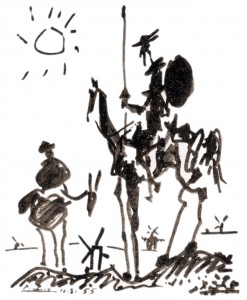The publishing industry has embarked on a quixotic journey. A recent Adweek article announces that “Close to 100 titles are planning to sacrifice prominent placements in their issues for an industry campaign.” Their tilted windmill is a sense that we have all simply forgotten how wonderful their product is, and that by running ads they can remind us. I can’t help but picture a group of buggy whip salesmen on the side of the road laughing at a car with a flat tire, secure in the knowledge that a horse would never succumb to such embarassment.
From a pure strategic standpoint, this makes little sense. It’s like a resort destination facing declining tourists putting up a billboard on their property saying, “We aren’t as bad as everything thinks we are!” First, the only people who will read the billboard are the very people they don’t need to reach – they are already reading the publication. Second, it’s a childish reaction that feels a bit like a spoiled brat throwing a tantrum in the middle of a store to protest the fact that reality is not aligned in the same direction they wish it to be.
Even more perplexing is the staggering self-delusion evident in their poor market perceptions. I will demonstrate this using direct quotes from the article:
- “We are ferociously determined to correct the misconceptions that have been swirling around the advertising industry,” said Moore. (Ann Moore, chairman and CEO, Time Inc.)
Rule #1 of marketing is that perception is reality. The only way to change reality is to change perception, and telling your customers, shareholders, and advertisers that they have been duped into believing myths doesn’t seem like a particularly effective way to do that. - “I believe magazines are the original mobile device,” she said.
True, but immaterial. One of the biggest mistakes the publishing industry is making right now is trying to force an old paradigm into a new technology. What’s worse, this comment was directed at a supposed “myth” that kids aren’t reading magazines. As the father of four daughters aged 4 through 15, I can see very clearly where the future of content consumption is going – and it will not involve paper. These publishers are the modern day version of ice harvesters (see story from Guy Kawasaki below). - “Magazines help us see beyond ourselves,” said Griffin. “They are voices of authority.”
I have absolutely no idea what that means. It smells a little bit like intellectual arrogance to me, but maybe that’s simply because I’m not smart enough for their sophisticated world. - “These are not just magazines, they are brands,” Black said. “They deserve your renewed interest.”
Deserve? Deserve!?!? As the American football coach Bill Pacells famously (well, famous in America at least) said, “You are what your record says you are.” In this case, your brand is what your customers say it is. To say that your own brand “deserves” anything is sad, pathetic, arrogant, and misguided – not to mention insulting to your customers.
Guy Kawasaki is Apple’s original brand evangelist and a renowned business strategist. He frequently uses the ice industry to talk about what he calls “curve jumping.”
One of the biggest mistakes you can make in life is to accept the known and resist the unknown. You should, in fact, do exactly the opposite: challenge the known and embrace the unknown.
Let me tell you a short story about ice. In the late 1800s there was a thriving ice industry in the Northeast. Companies would cut blocks of ice from frozen lakes and ponds and sell them around the world. The largest single shipment was 200 tons that was shipped to India. 100 tons got there unmelted, but this was enough to make a profit.
These ice harvesters, however, were put out of business by companies that invented mechanical ice makers. It was no longer necessary to cut and ship ice because companies could make it in any city during any season.
These ice makers, however, were put out of business by refrigerator companies. If it was convenient to make ice at a manufacturing plant, imagine how much better it was to make ice and create cold storage in everyone’s home.
You would think that the ice harvesters would see the advantages of ice making and adopt this technology. However, all they could think about was the known: better saws, better storage, better transportation.
Then you would think that the ice makers would see the advantages of refrigerators and adopt this technology. The truth is that the ice harvesters couldn’t embrace the unknown and jump their curve to the next curve.
Challenge the known and embrace the unknown, or you’ll be like the ice harvester and ice makers.
Then again, you could always just embark on a multi-million dollar advertising campaign to convince people about the myths of mechanically frozen ice and/or that lake ice deserves renewed interest.
